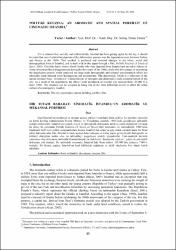| dc.contributor.author | Demir, Sertaç Timur | |
| dc.date.accessioned | 2017-07-04T08:00:05Z | |
| dc.date.available | 2017-07-04T08:00:05Z | |
| dc.date.issued | 2016 | |
| dc.identifier.uri | https://hdl.handle.net/20.500.11776/1760 | |
| dc.description.abstract | If it is claimed that, socially and architecturally, Istanbul has been getting uglier by the day, it should be noted that one of critical breakpoints of the deformation process was the deportation event between Turkey and Greece in the 1960s. That resulted in profound and essential changes in the urban, social and demographical form of Istanbul, and is dealt with in this paper through a film, Politiki Kouzina (A Touch of Spice, 2003). This film that is about a Greek family who were deported from Istanbul and moved to Athens by virtue of some political disagreements during the first years of the 1960s, deals with this change by examining the deportation process which catalysed the large-scale demographic and cultural transformation which has ethnically made Istanbul more homogenous and monophonic. The deportation, which is a reflection of the nation-oriented State, 'disinfected' Constatinople of strangers and destroyed a multi-coloured notion of the city. As a result of the deportation, the ethnic Greek population of Istanbul was reduced from 135,000 to a mere 7,000. This situation can be accepted as being one of the most influential events to affect the urban culture of contemporary Istanbul. | en_US |
| dc.description.abstract | Eğer İstanbul’un toplumsal ve mimari açıdan gittikçe bozulduğu iddia edilirse, bu çözülme sürecinin en kritik kırılma noktalarından birinin Türkiye ve Yunanistan arasında 1960’larda gerçekleşen mübadele olduğu söylenebilir. İstanbul’un kentsel, sosyal ve demografik dokusunda derin ve esaslı değişimler yol açan bu süreç, bu çalışmada Politiki Kouzina (A Touch of Spice) filmi üzerinden ele alınmaktadır. 1960’ların başlarında belli başlı politik anlaşmazlıklara binaen İstanbul’dan Atina’ya göç etmek zorunda kalan bir Rum ailesi hakkında olan film, İstanbul’u etnik açıdan daha homojen ve tektip yapan geniş ölçekli demografik ve kültürel dönüşüme neden olan bu mübadeleyi sorgulayıcı şekilde işlemektedir. Ulus-merkezli devletin yansıması olan sözkonusu mübadele Konstantinople’un ötekilerini ‘dezenfekte ederken’, şehrin de çok-renkli dokusunu yok etmiştir. Bu mübadele sonucuda, İstanbul’daki Rum nüfusu 135.000’den yalnızca 7.000’e inmiştir. Bu durum, çağdaş İstanbul’un kent kültürünü değiştiren en etkili olaylardan biri olarak kabul edilebilir. | en_US |
| dc.language.iso | eng | en_US |
| dc.publisher | Namık Kemal Üniversitesi,İktisadi ve İdari Bilimler Fakültesi | en_US |
| dc.rights | info:eu-repo/semantics/openAccess | en_US |
| dc.subject | The city | en_US |
| dc.subject | deportation | en_US |
| dc.subject | nation-building | en_US |
| dc.subject | conflict | en_US |
| dc.subject | film | en_US |
| dc.subject | Kent | en_US |
| dc.subject | mübadele | en_US |
| dc.subject | ulus-inşası | en_US |
| dc.subject | çatışma | en_US |
| dc.title | POLITIKI KOUZINA: AN AROMATIC AND SPATIAL PORTRAIT OF CINEMATIC ISTANBUL | en_US |
| dc.title.alternative | BİR TUTAM BAHARAT: SİNEMATİK İSTANBUL’UN AROMATİK VE MEKANSAL PORTRESİ | en_US |
| dc.type | article | en_US |
| dc.relation.ispartof | Balkan Sosyal Bilimler Dergisi | en_US |
| dc.department | Tekirdağ Namık Kemal Üniversitesi Dergileri | en_US |
| dc.authorid | 234523 | en_US |
| dc.identifier.volume | 5 | en_US |
| dc.identifier.issue | 10 | en_US |
| dc.identifier.startpage | 85 | en_US |
| dc.identifier.endpage | 97 | en_US |
| dc.relation.publicationcategory | Makale - Ulusal Hakemli Dergi - Kurum Öğretim Elemanı | en_US |



















